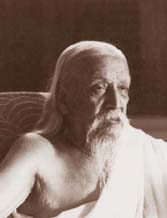
The development of the experience in its rapidity, its amplitude, the intensity and power of its results, depends primarily, in the beginning of the path and long after, on the aspiration and personal effort of the sadhaka. The process of Yoga is a turning of the human soul from the egoistic state of consciousness absorbed in the outward appearances and attractions of things to a higher state in which the Transcendent and Universal can pour itself into the individual mould and transform it. The first determining element of the siddhi is, therefore, the intensity of the turning, the force which directs the soul inward. The power of aspiration of the heart, the force of the will, the concentration of the mind, the perseverance and determination of the applied energy are the measure of that intensity. The ideal sadhaka should be able to say in the Biblical phrase, “My zeal for the Lord has eaten me up.” It is this zeal for the Lord,- utsaha, the zeal of the whole nature for its divine results, vyakulata, the heart’s eagerness for the attainment of the Divine,-that devours the ego and breaks up the limitations of its petty and narrow mould for the full and wide reception of that which it seeks, that which, being universal, exceeds and, being transcendent, surpasses even the largest and highest individual self and nature.
But this is only one side of the force that works for perfection. The process of the integral Yoga has three stages, not indeed sharply distinguished or separate, but in a certain measure successive. There must be, first, the effort towards at least an initial and enabling self-transcendence and contact with the Divine; next, the reception of that which transcends, that with which we have gained communion, into ourselves for the transformation of our whole conscious being; last, the utilisation of our transformed humanity as a divine centre in the world. So long as the contact with the Divine is not in some considerable degree established, so long as there is not some measure of sustained identity, syujya, the element of personal effort must normally predominate. But in proportion as this contact establishes itself, the sadhaka must become conscious that a force other than his own, a force transcending his egoistic endeavour and capacity, is at work in him and to this Power he learns progressively to submit himself and delivers up to it the charge of his Yoga. In the end his own will and force become one with the higher Power; he merges them in the divine Will and its transcendent and universal Force. He finds it thenceforward presiding over the necessary transformation of his mental, vital and physical being with an impartial wisdom and provident effectivity of which the eager and interested ego is not capable. It is when this identification and this self-merging are complete that the divine centre in the world is ready. Purified, liberated, plastic, illumined, it can begin to serve as a means for the direct action of a supreme Power in the larger Yoga of humanity or superhumanity, of the earth’s spiritual progression or its transformation.
Sri Aurobindo





